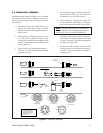10 Pelco Manual C550M-E (8/97)
5.0 OPERATION
In general, all operating controls on the transmitter are
self explanatory. With the exception of the ON/OFF
power switch and the 8-position joystick, all controls
are center-off, spring return paddle switches (momen-
tary on-off-on).
5.1 FUNCTIONAL CIRCUIT DESCRIPTION
The basic functional concept of the Coaxitron system is
that 15 control pulses are fed in a reverse direction from
the control transmitter to the receiver located near each
camera station. These control pulses do not interfere
with the video monitor presentation because they occur
during the vertical blanking interval of the video signal.
The equipment is designed to operate with video cable
lengths up to 750 feet of RG59B/U (or equivalent), or up
to 1,800 feet of RG11. The SW1 switch prominently
located on the receiver board (PCB1500529), should be
moved to the LONG position when RG59B/U cable of
greater than 750 feet is used (see Figure 3).
Cable impedance matching is insured by the video
amplifier in the control receiver. Proper receiving
and termination impedance is likewise insured by the
terminating resistor in the control transmitter.
Any equipment placed between the remote and local
locations must be of the “loop-through” or “bridging”
type; power splitter or line amplifiers cannot be toler-
ated.
Response time of the system is normally less than 30
ms. Error detection circuitry is incorporated to immu-
nize the system from externally generated noise. Under
extremely adverse environmental noise conditions re-
sponse time may increase, and in the limit, control
functions can fail. Under such extreme conditions,
however, provision is made to inhibit all momentary
functions.
The proper function of the Coaxitron system depends
on the compatibility of two signals simultaneously
traveling in opposite directions in the same coaxial
cable. If the control signal is made large, compared to
the video signal, there is the risk that associated equip-
ment will be adversely affected. If the control signal is
made small, compared to the video signal, it becomes
difficult to separate it from the video signal (and any
incumbent noise or hum). Therefore, the Coaxitron
system is designed to function with video and control
signals nominally equal.
Under such circumstances, reliable performance can be
predicted with cable lengths of 1,500 feet or more.
Beyond this distance, the control signal amplitude can
become attenuated sufficiently to make performance
marginal. Marginal performance is also approached if
the video signal is allowed to become excessive — the
dynamic range of the receiver video amplifier is one
limitation. Sending end distortion produced by the
coaxial cable is typically the major contributor to the
malfunctioning of a Coaxitron system. The amplitude
of distortion products is proportional to video signal
amplitude and is a non-linear function of cable length.
The influence of these distortion products upon system
performance is difficult to predict if signal amplitude is
allowed to exceed specifications.
Normally, auto-target or auto-iris functions will main-
tain a video level well within reasonable limits and
insure reliable performance. Often, however, automatic
or manual level settings may be made abnormally high
(perhaps to compensate for long cable losses or to
produce a picture with more contrast). An excessively
high video level setting can cause the Coaxitron control
system to fail completely — with all control functions
disabled. In order to prevent system failures due to
excessively high video levels, it is recommended that
cameras be powered by the receiver.
The Coaxitron System 2000 is designed to combat
prolonged loss of control due to the conditions de-
scribed above by providing the following protective
functions:
1. Simultaneous commands from two different
sources are processed to insure that manual iris
control cannot be inadvertently selected in
place of automatic control.
2. A sustained (20 to 40 second) illegal command
condition results in (a) camera off,
(b) automatic iris, or (c) manual pan.
These functions greatly reduce the possibility of loss of
control and usually eliminate the need for service.


















